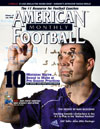AMERICAN FOOTBALL MONTHLY THE #1 RESOURCE FOR FOOTBALL COACHES
Article CategoriesAFM Magazine
|
Developing a Dominating Run Blocking TechniqueCastleton State\'s Rich Alercio\'s Heel-to-Toe Philosophy on the Secret of Man Blockingby: Mike Kuchar Senior Writer, American Football Monthly © More from this issue Talk to any football coach worth his salt and he’ll tell you that you win or lose up front. Playing the offensive line at any level, is a high risk-low reward job occupation with an image encapsulated in grunt work, doing the bear essentials to help your team win. Perhaps nobody possesses that element more than Rich Alercio, the first head football coach at Division III Castleton University, in Castleton VT. Alercio and his 22 years of football coaching experience were hired last February to be the first head coach in school history. Standing not a shade over 5-10, and possessing a prototypical O-line coaches grunting vocals, Alercio played the position at Ursinus College and was fortunate enough to learn from a disciple of Jim McNally, who most consider to be the quintessential offensive line guru. An offensive l....The full article can only be seen by subscribers. Subscribe today!
|
|
|||||||
| HOME |
MAGAZINE |
SUBSCRIBE | ONLINE COLUMNISTS | COACHING VIDEOS |
Copyright 2025, AmericanFootballMonthly.com
All Rights Reserved





